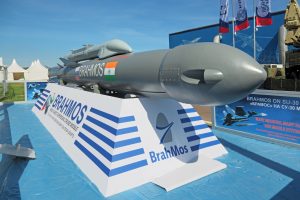Indonesian President Prabowo Subianto conducted a state visit to India on January 23-26, and while both countries agreed to increase cooperation in defense and security, a much-anticipated subject was left out of the official documents: the purchase of the BrahMos supersonic cruise missile.
Indonesia’s BrahMos purchase plan has garnered attention from both academic circles and the public in recent months. The government resurfaced its interest late last year, with Navy Chief of Staff (KSAL) Adm. Muhammad Ali raising the issue during a meeting with his Indian counterpart, Adm. Dinesh Kumar Tripathi, at the Navy Headquarters, Cilangkap on December 16.
Following the meeting, BrahMos and PT PAL conducted several visits and studies regarding the compatibility of the BrahMos anti-ship missile with Indonesian warships. An Indonesian delegation led by Adm. Muhammad Ali also visited the BrahMos Aerospace headquarters on January 27 and was briefed on the capabilities of the supersonic cruise missile.
Whether Indonesia will procure BrahMos is unclear, but it is clear that Indonesia needs to modernize its naval capabilities and strengthen its security, and BrahMos is an interesting option.
The BrahMos is a missile weapon system co-produced by India and Russia. With a name originating from the Brahmaputra and Moskva Rivers, it has a supersonic feature with a velocity of around Mach 2.8-3.0. It also has a range of around 290 kilometers for its export version. The missile is also known for its versatility since it can be launched from land, ship, submarine, or air platforms.
With these capabilities, BrahMos’ procurement is attractive to the Indonesian Navy to increase its capacity for supersonic missiles, considering the Yakhont missile system is only equipped in one Ahmad Yani-class frigate, KRI Oswald Siahaan. In addition, BrahMos, as a newer generation missile, is equipped with a more sophisticated guidance system than Yakhont, presenting an opportunity to supplement Yakhont’s capabilities.
Anti-ship missiles have always had their place in Indonesia’s strategic vision, which is to secure its maritime territory amid increasing geopolitical tensions. The country possesses several critical choke points (the Malacca, Sunda, Lombok, and Makassar straits) that are the primary route for Indonesia’s logistics. Around 40 percent of the world’s commerce freight ships pass through these points. The width of each choke point varies, from 18 kilometers in the narrowest part of the Lombok Strait to 300 kilometers at the Makassar Strait’s widest point. With this in mind, procuring BrahMos could fill a range gap in Indonesia’s current anti-ship missiles at these choke points, strengthening the capability of Indonesia’s maritime defense posture while supporting Indonesia’s commitment to maintain the security of the world’s sea routes.
However, the Indonesian BrahMos deal does not stop with its military use. BrahMos’ procurement also symbolizes Indonesia’s strategic outlook on its supply chain and diplomacy.
The procurement of BrahMos from India may be seen also as Indonesia’s effort to diversify its arms supply chain to prevent import dependence on countries in geopolitical hotspots, which spells high supply chain risk. Research by LAB45 found that geopolitical tensions increase the trend of arms export priority to countries within the same bloc, making it difficult for arms-importing countries that do not take sides, such as Indonesia. Thus, Indonesia needs to seek a more secure arms supply chain from producers outside the warring geopolitical blocs, including India.
This diversification effort is also closely related to the potential for Countering America’s Adversaries Through Sanctions Act (CAATSA) sanctions from the U.S. if Indonesia supplies its arms with components from Russia and China. India has guaranteed BrahMos to be CAATSA-free since the missile core components are produced domestically in India, unlike Yakhont, whose production is still centered in Russia. This CAATSA-free claim has been validated by the fact that the recent BrahMos deal with the Philippines, a long-time U.S. ally, proceeding uninterrupted.
Meanwhile, from a diplomatic perspective, the procurement of BrahMos missiles can be seen as the implementation of Prabowo’s “Good Neighbor Policy” which seeks to maintain good bilateral relations and partnerships with the major regional and global powers. This includes India, whose territory borders Indonesia in the Andaman Islands and Indian Ocean.
Engagements between Indonesia and India have also been increasing recently, notably after the bilateral meeting between Prabowo and Indian Prime Minister Narendra Modi at the G-20 Summit in Rio de Janeiro, Brazil in November. That was followed by a visit from the Indian warship INS Mysore to Indonesia the following month, which was itself followed by a series of meetings between the Navy Chief of Staff from both countries. The BrahMos deal may become a concrete means for Indonesia to lock in a strategic partnership with India in the maritime sector and the Indo-Pacific region.
But questions remain regarding long-term operational and maintenance issues, and on how Indonesia can avoid another weapons system dependency.
Since BrahMos was partly made by Russia’s defense industry, Indonesia will likely undertake careful studies on the system’s interoperability with Indonesia’s Western-made ships. Indeed, PT PAL has experience fitting Yakhont missiles to Ahmad Yani-class frigates. However, those frigates are now quite old and ought to be replaced with a new generation, necessitating a well-planned effort to integrate the BrahMos missile system into newer ships, too.
In addition, efforts to encourage technology and knowledge transfer must be a top priority to support the development of Indonesia’s defense industry. Thus, it may come as a relief that India has agreed to support Indonesia’s ongoing defense modernization programs through experience and expertise sharing.
With interoperability enhancement and thoughtful technology-knowledge transfer, the BrahMos deal will not only be just a capable anti-ship missile to support the modernization of the Indonesian Navy, but it can also open a new era of cooperation and defense diplomacy between Indonesia and major regional players like India.

































